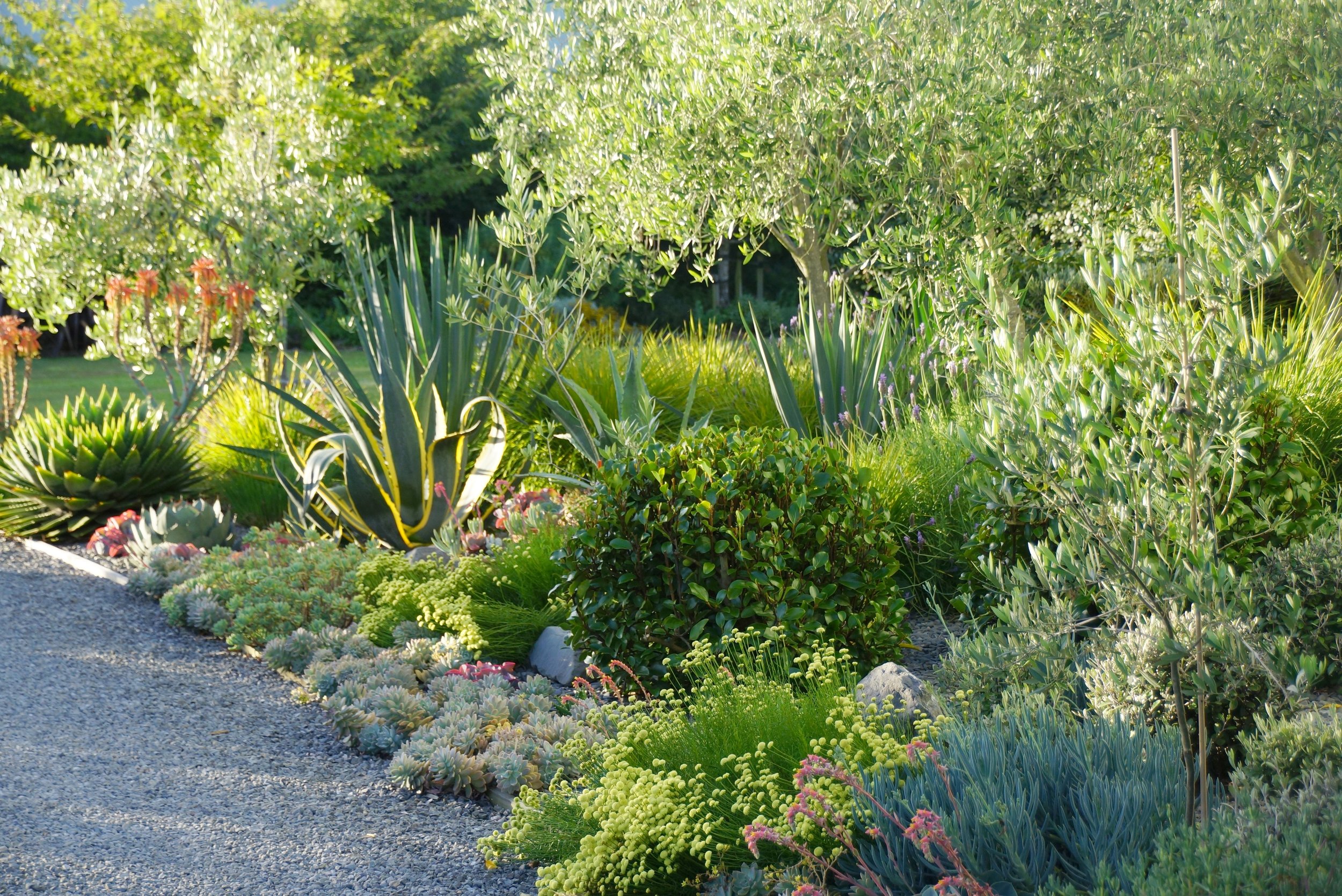Jenny Cooper, Embracing the Dry
At the New Zealand Garden’s Trust conference in Blenheim, attendees were delighted to hear some wise advice from Jenny Cooper, who gardens in Amberly, North Canterbury at ‘The Blue House’. The following is a summary of her presentation:
Jenny Cooper is a convert to less is more, when it comes to soil preparation. She began her gardening journey 40 or so years ago, using the old garden guides around at the time. These stressed the need for elaborate homemade composts, mulch, fertilisers and so on – as if the existing soil was somehow inadequate. So, she mulched, fertilised, watered and worked mountains of compost into her soil.
This worked fine when Jenny had smaller urban gardens. But in 2013 she, and her partner Chris, bought an acre of bare land north of Amberley in North Canterbury. She started out gardening in her traditional way, but soon found that well fed and well-watered plants are incredibly hard to look after in such a dry windy site.
The plants grew quickly, far too quickly. The rich moist soil led to lush tall growth, and she seemed to be forever chopping, propping, tying in, deadheading, and repairing damage from the wind, or moving endless hoses. Weary of being the slave to the garden, she decided that this style of gardening was too high maintenance in North Canterbury’s dry, hot summer. After much research into Mediterranean and summer-dry gardening techniques, (note: ‘summer-dry’ means the only irrigation is the natural rainfall of the area. There is no supplemental watering) she changed her garden style to no-dig, no soil amendments, and no fertilisers, but with deep ramial woodchip mulch. She also learned to group her plants according to their water needs, realising that it is the one wilting plant which makes us put on the hose for the whole area. Plants are now grouped in watering ‘zones’, so that in the height of summer, Jenny knows whether they’ll need water once a week (such as the veggie garden), once a fortnight, once a month, or not at all.
The ‘summer-dry’ zones can make it through the entire summer with only 650mm of rain, without supplemental water. Some of these beds are mulched with pea gravel, but many of Jenny’s driest beds are mulched with ramial woodchip (the whole tree mulched up, from leaf to trunk). The woodchip encourages mycorrhizal fungi at the plant’s roots, and it is the mycorrhizal fungi which bring water and nutrients to the plants.
She says it was quite a change of mind set NOT to feed, (which she recalls as being scary), as she had previously been such a heavy user of homemade compost etc., over the whole garden. Now the compost only goes on the productive garden, and everything else gets either gravel or woodchip mulch, and nothing else. This has created a much lower, slower garden. It is calmer and much less work, and Jenny finds it has richer colours and the plants are more upright and self-supporting. When the summer nor ‘west wind blows, plants grown in this lean fashion can cope without wilting, breaking or burning.
She explained that most plants are very adaptable and can change their growth form depending on environment so Jenny provided the plants with the hardest environment she could. The result: easy on the gardener, and hard on the plants! However she says not every plant will cooperate with this harsh regime and that it is necessary to research to get the right plants which are able to adapt well to the rigours of ‘going it alone’. Plants which did well in her garden under this regime were: echium, many salvias, euphorbias, artemesia, yucca, baptisia, bupleurum, balotta, marrubium, frost hardy succulents, blue oat grass, leonotis leonurus, stipa, calamagrostis, and many more. It is surprising which plants will not just survive, but thrive in a non-watered bed. Many plants perform much better without water and food, and are less invasive, easier to control, and become great garden citizens. For example: euphorbia grifithii Dixter, artemesia Valerie Finnis, crocosmia, gaura, lavender, sedum all perform much better in a lean dry garden.
She says that the research shows that most gardens can be fed and watered much less than we have been led to believe. There is quite an art to changing a fed and watered garden into a ‘summer-dry’ garden, and a truly low-water or summer-dry garden is often easier to establish from scratch. Starting with soil that has never had amendments added, and planting tiny plants, are two of the best things you can do.
Jenny’s main message in her talk was to believe in your soil because it is not as compacted or depleted as you have been led to think. (Apart from new subdivisions, which are a different, and often tragic case!). Jenny’s own soil is mostly light, sandy, lean, and highly mineralic. But she does NOT work in organic matter, as traditionally advised. Instead she works with her natural soil, planting varieties which love these conditions, and mulching with deep woodchip.. From originally seeing her native soil as ‘poor’, she now loves her free-draining soil, as there are heaps of Mediterranean type plants which thrive here. This is ‘gardening where you are’. Thus the garden becomes an expression of the natural environment, and not a copy of every beautiful UK garden we see in the media.
Having plants with excellent, natural root structures is key. She tries not to buy from a nursery, as nursery plants often have over-mature roots which are reliant on regular watering and feeding. Rather she grows from seed or cuttings, planting the plants at really small size so that their vigorous youth is lived in the soil, not the pot. When she does buy plants, especially woody species, she tries to buy them as small as possible. Trees and shrubs have permanent structures above and below ground, and it is important to plant small specimens, before they become pot bound or have girdling roots.
Jenny did not install irrigation – doing so just freezes the garden in time and makes plants and gardener dependent on this scarce resource. Most of her plants are planted in autumn, taking advantage of winter rains. Traditionally we’ve been told to plant in spring because this is when it’s best to plant – in the UK! Jenny has been noticing that Monty Don is now advising to plant in autumn, as even the UK is experiencing summer drought. Jenny plants when the roots are growing strongly and she doesn’t worry about the tops. A good root system will eventually produce good top growth, but weak/girdling roots dependent on synthetic fertiliser will often not catch up with top growth. Many nursery grown plants have too much top growth for their poorly grown and congested roots. She often resorts to chopping the top off a nursery grown plant, so that it can reshoot in proportion to its own roots.
Jenny sums up her 9 year garden journey: “I love my non-irrigated gardens because they are calm. They are not quite as seasonal as the conventional parts of the garden. But they are not the spikey, unloved, and dusty places people seem to associate with dry gardens or easy care gardens. I find them both more creative, more rewarding, far less work, and far far cheaper to maintain. Not to mention fewer water bills. Not every garden has to be a race for the most flowers and the biggest bloom.
I don’t do this to save water: although the Hurunui region doesn’t need me chucking a mountain of water everywhere. I do it to save time, and because I have found I love these slow, more gentle, more reliable beds. I never have to worry about them. And when every other part of the garden is needy, thirsty, and time consuming, the summer dry garden will hum along peacefully. Slowly increasing, basking in the sun, requiring no hoses, loving the wind, perfectly climate adapted for a long hot Canterbury summer”.
For more information, check out Jenny’s website bluehouseamberley.nz, @bluehouseamberley on Instagram and bluehouse_amberley on facebook.
Blue House is an open garden and is also in the Hurunui Garden Festival from 31 October to 3 November 2024.






